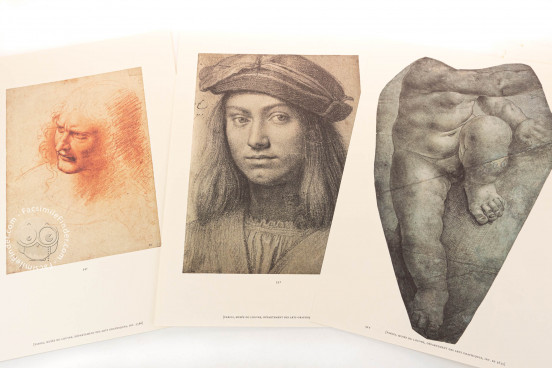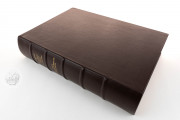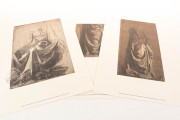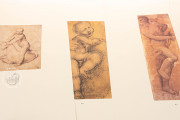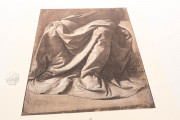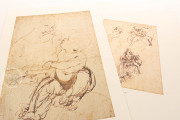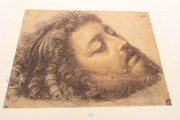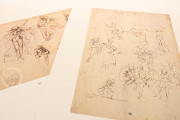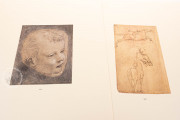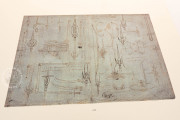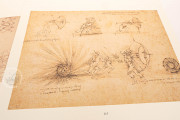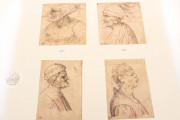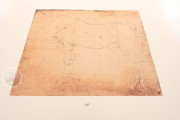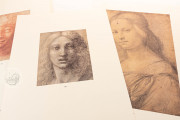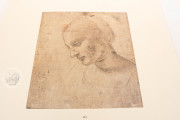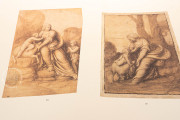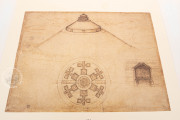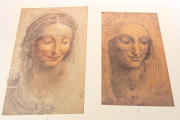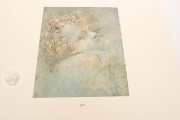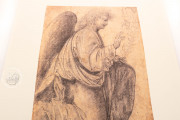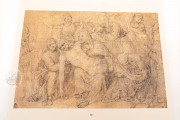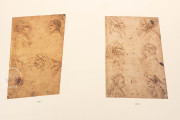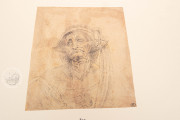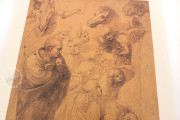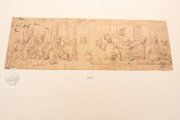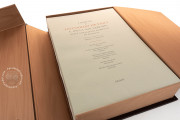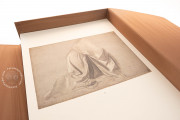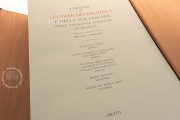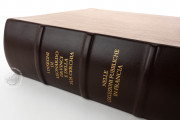This collection features the reproduction of 114 drawings, including a core of forty drawings by Leonardo himself and seventy-four among school drawings, works by his followers, and copies. The original drawings are preserved in the collections of five French museum institutions, namely the Département des Arts Graphiques of the Musée du Louvre (formerly the Cabinet des Dessins), the École Nationale Supérieure des Beaux Arts in Paris, the Fondation Custodia - Institut Néerlandais in Paris, the Musée Bonnat in Bayonne, and the Musée des Beaux Arts in Rennes.
The selection of these institutions was primarily due to the presence of Leonardo's original or traditionally attributed sheets within their collections, supplemented by a curated selection of his pupils' works, followers', and copies of the artist's drawings and paintings.
The collection is structured as follows:
I. LEONARDO
1-9. In Verrocchio's Workshop (ca. 1467-1472 or shortly thereafter)
10-13. Early Studies (ca. 1478-1480)
14-19. Figures and Animals for "Nativity" and "Adorations" (ca. 1480-1482)
20-27. Milan (ca. 1483-1490)
28-35. Allegories, "Grotesque Heads" and Other Studies (ca. 1490-1497)
36-40. Between Mantua, Florence, and Milan (ca. 1500-1507/1510)
II. FIRST STUDENTS AND FOLLOWERS
41-61. Giovanni Ambrogio de' Predis, Marco d'Oggiono, Master of the Sforzesca Altarpiece, Giovan Antonio Boltraffio, Giovanni Agostino da Lodi, Andrea Solario
III. SECOND GENERATION FOLLOWERS
62-74. Cesare da Sesto, Bernardino Luini, Giampietrino
IV. SCHOOL
75-92. School Drawings, fifteenth-sixteenth centuries
V. COPIES
93-114. Copies, sixteenth-seventeenth centuries
A Shared Provenance
The focus of this collection is on the French collections that preserve Leonardo's autographs, with a refined selection that represents the impact and legacy of Leonardo's work among French collectors. This selection is limited to significant drawings, either by identified members of the "Leonardeschi" group or, in the case of anonymous works or copies, to those that can offer an insight into Leonardo's and his followers' renown in France. The collected Leonardo drawings in the five French museums often share a provenance history, with some papers historically passing through the hands of notable collectors such as Everhard Jabach, Giuseppe Bossi, Giuseppe Vallardi, and His De La Salle, whose names appear linked to many of the drawings now located in separate institutions.
Département des Arts Graphiques of the Musée du Louvre
The primary focus of this collection is on the Leonardo drawings from the Louvre's Département des Arts Graphiques (excluding the drawings unrelated to the Italian domain), with selective inclusion from other French public collections based on exceptional quality, complementing the core collection at the Louvre. The collection thus features twenty-two Leonardo sheets at the Louvre (many double-sided) and an additional eighteen sheets across the other collections mentioned, totaling forty drawings attributable to the master. The collection begins with the Leonardo drawings from the Louvre's Département des Arts Graphiques and those from other French institutions (plates 1-40), offering a logical sequence that illustrates the evolution of Leonardo's graphic techniques and themes that tie into his artistic, technological, and architectural career, spanning from the late 1460s to around 1507-1510.
The Evolution of a Master's Technique
The forty drawings attributed to Leonardo compiled here offer a comprehensive overview of his graphic techniques and the evolution of his drawing style over a forty-year career. Arranged in roughly chronological order, they trace nearly all phases of his work, displaying the various media favored by Leonardo, from his master Andrea del Verrocchio's influence in his early linen canvas brushwork, to the pen and ink characteristic of his Florentine period, and finally to the atmospheric Lombard style. Despite the consistent use of pen and ink, the Milanese period marked a technical shift towards red and black chalk as Leonardo needed to capture visual impressions on paper or in his notebooks instantly, even while on the move. This collection, therefore, offers an almost complete case study of Leonardo's graphic techniques, enriched by mixed media examples.
We have 1 facsimile edition of the manuscript "Drawings by Leonardo da Vinci and His Circle - French Public Collections (Collection)": I disegni di Leonardo da Vinci e della sua cerchia - Collezioni pubbliche di Francia facsimile edition, published by Giunti Editore, 2008
Request Info / Price
